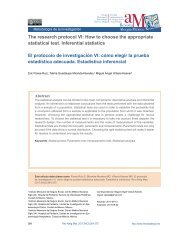EQ-5D-3L UserGuide 2015
You also want an ePaper? Increase the reach of your titles
YUMPU automatically turns print PDFs into web optimized ePapers that Google loves.
6. Presenting <strong>EQ</strong>-<strong>5D</strong>-<strong>3L</strong> results<br />
Data collected using <strong>EQ</strong>-<strong>5D</strong>-<strong>3L</strong> can be presented in various ways. A basic subdivision can be made<br />
according to the structure of the <strong>EQ</strong>-<strong>5D</strong>-<strong>3L</strong>:<br />
1. Presenting results from the descriptive system as a health profile<br />
2. Presenting results of the <strong>EQ</strong> VAS as a measure of overall self-rated health status<br />
3. Presenting results from the <strong>EQ</strong>-<strong>5D</strong>-<strong>3L</strong> index value<br />
The way results can be presented is determined both by the data and by what message you, as a<br />
researcher, wish to convey to your audience.<br />
6.1. Health profiles<br />
One way of presenting data as a health profile is by making a table with the frequency or the<br />
proportion of reported problems for each level for each dimension. These tables can be broken down<br />
to include the proportions per subgroup, such as age, before vs. after treatment, treatment vs.<br />
comparator, etc.<br />
Sometimes it is more convenient to dichotomise the <strong>EQ</strong>-<strong>5D</strong> levels into 'no problems' (i.e. level 1) and<br />
'problems' (i.e. levels 2 and 3), thereby changing the profile into frequencies of reported problems.<br />
This can be the case, for example, in a general population survey where the numbers of reported<br />
level 3 problems are very low. Tables 2 and 3 are examples of how to present <strong>EQ</strong>-<strong>5D</strong> data in<br />
tabulated form. The data for the tables originates from a general population survey in the UK 2 .<br />
Table 2: Proportion of levels 1, 2 and 3 by dimension and by age group<br />
AGE GROUPS<br />
<strong>EQ</strong>-<strong>5D</strong> DIMENSION 18-29 30-39 40-49 50-59 60-69 70-79 80+ TOTAL<br />
Level 1 95.4 92.2 89.7 78.1 70.7 60.2 43.3 81.6<br />
MOBILITY Level 2 4.6 7.6 9.9 21.9 29.3 39.8 56.7 18.3<br />
Level 3 0.0 0.1 0.4 0.0 0.0 0.0 0.0 0.1<br />
Level 1 99.1 98.4 95.8 94.8 94.3 92.6 83.7 95.7<br />
SELF-CARE Level 2 0.9 1.5 4.0 5.2 5.5 7.1 15.6 4.1<br />
Level 3 0.0 0.1 0.2 0.0 0.2 0.2 0.7 0.1<br />
USUAL<br />
ACTIVITIES<br />
PAIN /<br />
DISCOMFORT<br />
ANXIETY /<br />
DEPRESSION<br />
Level 1 93.3 91.4 89.2 78.1 75.3 73.7 56.0 83.7<br />
Level 2 6.3 7.9 9.4 18.8 21.6 22.1 38.3 14.2<br />
Level 3 0.4 0.7 1.5 3.0 3.1 4.2 5.7 2.1<br />
Level 1 83.9 80.7 74.1 56.3 53.8 44.0 39.7 67.0<br />
Level 2 15.8 17.7 22.8 38.1 40.6 48.4 49.6 29.2<br />
Level 3 0.3 1.6 3.1 5.6 5.6 7.6 10.6 3.8<br />
Level 1 86.5 82.6 81.3 72.8 72.0 74.7 75.2 79.1<br />
Level 2 12.6 16.4 16.9 24.4 25.1 22.6 24.1 19.1<br />
Level 3 0.9 1.0 1.8 2.8 2.9 2.7 0.7 1.8<br />
2 Kind P, Dolan P, Gudex C, Williams A. Variations in population health status: results from a United Kingdom<br />
national questionnaire survey Bmj 1998;316 (7133): 736-41.<br />
Page | 12


















